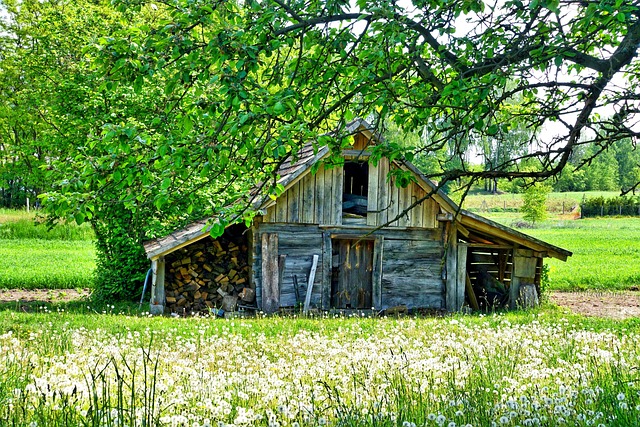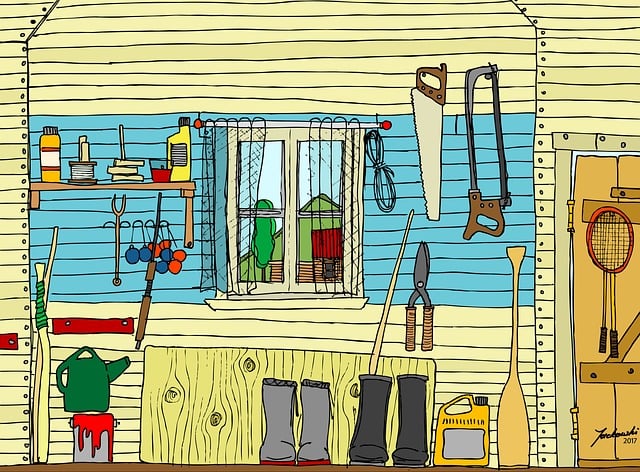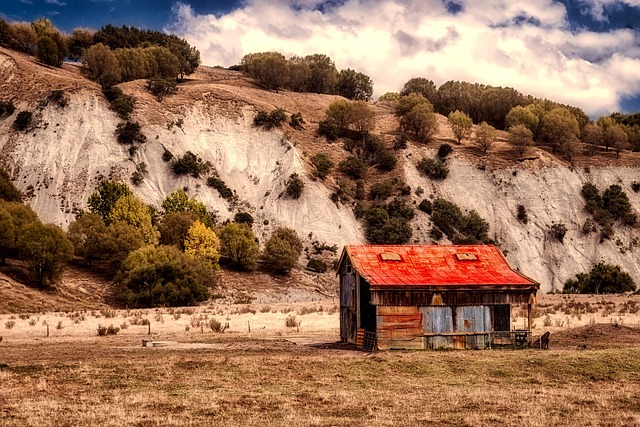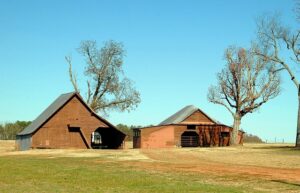In Wagga Wagga’s Riverina region, farm shed designs are tailored to withstand the area’s extreme seasonal changes, from scorching summers to temperate winters. These structures are engineered to align with prevailing winds, accommodate heavy rainfall, and protect against high UV levels, storms, and hail. Strategic placement ensures minimal wind impact, optimal natural light, and ventilation for temperature control. Durable materials like Colorbond steel are used for construction to endure the region’s weather extremes, safeguarding agricultural assets. Advanced design principles include efficient guttering systems, thermal insulation, heat-reflective roofing, and aerodynamic shapes to minimize wind damage. Recent technological advancements have enhanced temperature control with smart evaporative cooling systems and high-efficiency fans that respond to weather conditions, maintaining a comfortable environment for livestock and crops. The integration of solar panels and retrofitting of traditional sheds with smart monitoring technology exemplifies the region’s commitment to sustainable and efficient farming practices, underscoring the importance of farm sheds as integral components in enhancing agricultural resilience amidst Wagga Wagga’s diverse climatic challenges.
Exploring the robust design and construction of farm sheds tailored for Wagga’s dynamic weather conditions, this article delves into the essential considerations for safeguarding agricultural assets. From harnessing the region’s prevailing wind patterns to leveraging cutting-edge climate control systems, discover how modern farm shed solutions optimize storage and productivity amidst Wagga’s varied climates. Farmers will find valuable insights across key sections, including weather patterns, design strategies, material selection, and real-world success stories, ensuring their operations remain resilient against the elements.
- Understanding Wagga’s Weather Patterns and Their Impact on Farming
- Design Considerations for Farm Sheds to Withstand Wagga’s Climate
- Durable Materials: The Foundation of Weather-Resistant Farm Sheds in Wagga
- Advanced Technologies for Temperature Control and Ventilation in Farm Sheds
- Case Studies: Successful Farm Shed Implementations in Wagga’s Agricultural Landscape
Understanding Wagga’s Weather Patterns and Their Impact on Farming

In the Riverina region of New South Wales, Australia, Wagga Wagga experiences a diverse range of weather patterns, ranging from harsh summers with high evaporation rates to relatively mild winters. These conditions necessitate robust and versatile farm structures that can withstand and adapt to such variability. Farmers in the Wagga area must design their farm sheds with consideration for the region’s prevailing winds, heavy rainfall, and extreme temperatures to protect crops and machinery throughout the year. Understanding these weather patterns is crucial for optimizing shed placement and orientation to minimize wind exposure and maximize natural lighting and ventilation during the warmer months.
The impact of Wagga’s unpredictable weather on farming cannot be overstated. Farm sheds must be designed with materials that can endure the region’s high UV levels, as well as resist damage from storms and hail. Adequate shelter is essential to protect livestock, equipment, and crops from the elements, ensuring their longevity and productivity. Moreover, farm sheds should be constructed to facilitate easy adaptation for different purposes, such as storage during off-seasons or as animal shelters when needed. By leveraging durable materials and smart design, farm sheds can offer a cost-effective solution to the challenges posed by Wagga’s weather, enhancing the resilience of local agricultural operations. Farmers in the region are increasingly turning to customizable farm shed solutions that cater to their specific needs, thereby safeguarding their investments against the capriciousness of the local climate.
Design Considerations for Farm Sheds to Withstand Wagga’s Climate

In the rugged Wagga region, farm sheds are subject to a diverse array of climatic conditions that demand careful design considerations. To withstand the harsh sun, farm sheds must be equipped with high-quality insulation and durable roofing materials that reflect heat while maintaining energy efficiency. The orientation of the shed should optimize natural light without compromising thermal performance, a delicate balance crucial for both productivity and resource conservation. Additionally, the design must account for the prevailing winds; structures should be anchored with stability in mind to prevent damage during gusty conditions common to the area.
Local farm sheds also need to be resilient against the unpredictable weather patterns, including torrential rainfall and potential hailstorms. Employing robust materials for walls and roofs, such as Colorbond steel, can provide the necessary strength and longevity. Designers must prioritize runoff management with effective guttering systems to channel water away from the structure, minimizing the risk of water damage. Furthermore, strategic ventilation is essential to ensure proper air circulation during hot spells, reducing the likelihood of overheating and protecting valuable agricultural equipment from the elements. With careful planning and attention to these design elements, farm sheds in Wagga can be both functional and resilient, standing up to the challenges posed by its unique climate.
Durable Materials: The Foundation of Weather-Resistant Farm Sheds in Wagga

In the agriculturally rich region of Wagga Wagga, where weather patterns can be unpredictable and harsh, farm sheds serve as indispensable assets for safeguarding crops, machinery, and livestock. The durability of these structures is paramara by the materials chosen for their construction. High-grade steel, galvanized iron, and reinforced concrete are the bedrock upon which weather-resistant farm sheds stand strong against the elements. These materials not only withstand the relentless barrage of sun, wind, and rain but also provide a resilient framework that can endure the test of time. The design of these sheds often incorporates aerodynamic features to minimize the impact of high winds, while the roofing, typically consisting of corrugated steel, is engineered to shed water effectively, preventing leaks that could damage stored goods or compromise the integrity of the structure over time. Moreover, these materials are selected not only for their resilience but also for their low maintenance requirements, ensuring that farmers can focus on their primary operations without the constant concern of structural upkeep. The strategic placement and design of farm sheds in Wagga Wagga, utilizing top-tier materials, exemplify a commitment to protecting agricultural assets from the challenging weather conditions characteristic of the region.
Advanced Technologies for Temperature Control and Ventilation in Farm Sheds

In recent years, the integration of advanced technologies for temperature control and ventilation in farm sheds has significantly improved the ability of farmers in Wagga Wagga to protect their livestock and crops from the region’s challenging weather conditions. These innovations are designed to maintain optimal temperatures within the shed, ensuring the well-being of animals and the quality of stored produce. For instance, evaporative cooling systems have been enhanced with smart controls that activate cooling only when ambient temperatures reach a certain threshold, conserving energy and reducing costs. Additionally, high-efficiency fans are installed to circulate air and regulate humidity levels, providing a comfortable environment for livestock even during the sweltering heat of summer. These fans can be automated with weather sensors that predict temperature changes, allowing for proactive adjustments to ventilation based on forecasted conditions.
Furthermore, farm sheds equipped with insulation materials and energy-efficient roof designs are better suited to retain heat during the cooler months, reducing reliance on artificial heating sources. Infrared heating options are also available for use when natural light is insufficient to maintain warmth. The integration of these technologies not only contributes to the longevity and durability of farm sheds but also supports sustainable farming practices by minimizing the environmental impact of temperature control mechanisms. As a result, farmers in Wagga Wagga can invest in these smart solutions to create a resilient microclimate within their farm sheds, safeguarding their investments against the volatile weather patterns characteristic of the region.
Case Studies: Successful Farm Shed Implementations in Wagga’s Agricultural Landscape

In the agricultural heartland of Wagga Wagga, the resilience of farm sheds has been tested and proven under a spectrum of weather conditions. The region’s farmers have implemented innovative farm shed designs that stand as testaments to their adaptability and resourcefulness. For instance, one successful case study involves the adoption of multi-purpose sheds equipped with reinforced structures and weatherproof materials. These enhancements have allowed for the safe storage of machinery and livestock, even during the most adverse weather events. The strategic placement of these sheds, often oriented to capture natural sunlight while providing shelter from prevailing winds, has also been a key factor in their success. Additionally, incorporating energy-efficient designs and solar panels further reduces operational costs, showcasing the economic benefits alongside the structural advantages.
Another notable case study is the transformation of traditional farm sheds into high-tech hubs that monitor and manage livestock health and crop conditions remotely. By leveraging smart technologies, these farms have achieved a new level of precision agriculture, which has significantly improved yield and efficiency. The integration of advanced climate control systems within these sheds ensures that temperature and humidity levels are optimized for the well-being of both crops and animals. These examples underscore the importance of farm sheds as versatile assets in Wagga’s agricultural landscape, capable of adapting to new technologies while enduring the region’s challenging weather patterns.
In conclusion, the design and construction of farm sheds in Wagga must account for the region’s diverse and sometimes challenging weather patterns. By integrating durable materials and leveraging advanced temperature control technologies with effective ventilation systems, local farmers can safeguard their crops and equipment from the elements. The case studies presented demonstrate the practical application and success of these measures within Wagga’s agricultural sector. Investing in robust farm sheds that cater to the specific climatic conditions of Wagga not only protects assets but also enhances productivity, ensuring the sustainability and prosperity of local farming operations. Farmers in Wagga are encouraged to prioritize resilient infrastructure as a key strategy for combating the unpredictable weather and maintaining the vitality of their agricultural endeavors.
